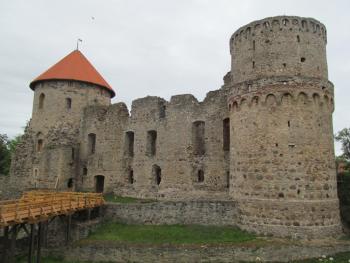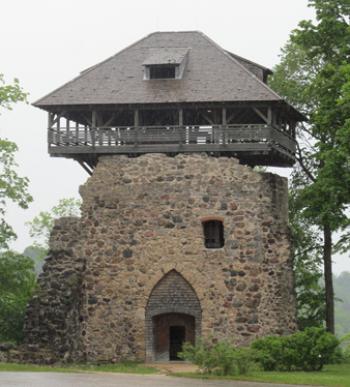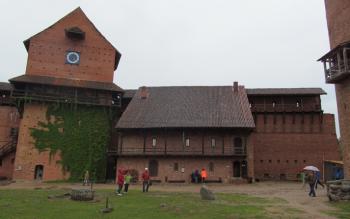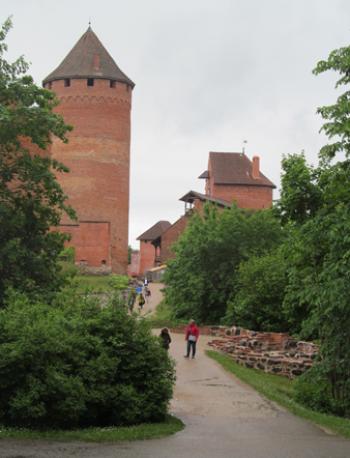A trio of Latvian castles
This item appears on page 49 of the March 2020 issue.
Riga, Latvia, was the second stop on a month-long trip that my husband, Paul, and I took to the Baltic states in May-June 2019. As with Tallinn, Estonia, our first stop (Feb. ’20, pg. 47), we had allotted eight days for Riga and, as with Tallinn, we could have spent all eight days exploring this vibrant city on the Baltic Sea, with its Old Town, wealth of Art Nouveau buildings and nearby seaside resort town of Jūrmala.
We also wanted to venture into the Latvian countryside to visit a few of the castles in which Latvia abounds. We chose three particular castles because all were fairly close to Riga — a total of 130 miles to reach all three, with a driving time of about 3½ hours, allowing us 5½ hours for sightseeing — making a busy day trip possible.
The castles we selected were linked in other ways. All were constructed in the early 13th century within a few years of each other, and all were related in some way to the Teutonic Order.
The Teutonic Order, a powerful religious military order of monk-knights, was originally founded at the end of the 12th century to protect Christian pilgrims in the Holy Land. Members also made it their mission to convert the pagans of what is now Estonia, Latvia and Lithuania — and elsewhere — to Christianity.
Cēsis Castle
The first castle we visited was Cēsis, located 60 miles east of Riga.
The Livonian Brothers of the Sword, later to become incorporated into the Teutonic Order and become known as the Livonian Order, built a stone castle about 1213 beside the hill fort of the Wends, a tribal group whom they had converted. The castle was a convent-fortress meant both for defense and as a residence for monks. Cēsis became the administrative center of the Livonian Order toward the end of the 15th century.
Cēsis’ downfall came during the Livonian War in 1577 when Czar Ivan IV, known also as Ivan the Terrible, captured the castle, with further damage inflicted when the Russians again invaded in 1703. A manor house, home to the noble, Baltic-German von Sievers family, was built in the mid-18th century steps away from the castle, incorporating stones from the castle.
It’s easy to envisage Cēsis Castle in its days of glory because so much remains: basic castle buildings, towers and outer walls. What we enjoyed most, however, was walking through the extensive castle park circling the castle to see it from all angles.
There’s a tour of the West Tower up a narrow spiral staircase to see the view and the Master’s living quarters. Candle lanterns are used to light the way — a romantic touch, we thought. There are also workshops on site offering demonstrations of various medieval crafts and trades.
Cēsis Castle (phone +371 6412 1815, www.cesupils.lv) is open daily from 10 to 6, April through September. From October through April it’s closed Mondays, and it’s best to check the hours online or call. Admission costs €3 (about $3.35).
Sigulda Castle
Sigulda Castle — also called Old Sigulda Castle — is 24 miles from Cēsis Castle and was, like its neighbor, built by the Livonian Brothers of the Sword.
Located in the beautiful Gauja Valley, it was constructed from 1204 to 1209, a few years before Cēsis Castle, and was meant for both defense and residence. As at Cēsis, monks lived there as well as high-ranking officers of the order.
Sigulda Castle shared the same fate as Cēsis in being heavily damaged in both the Livonian War and the Great Northern War until, by the early 18th century, it was a ruin in private hands.
There is also a New Sigulda Castle, a neo-Gothic manor house built in 1878 by a Russian prince, Dimitry Kropotkin.
Today, Sigulda Castle is still a ruin, albeit a romantic one only partially restored. There are remains of walls and towers, particularly the Main Gate Tower and the North Tower, the latter containing a medieval weaponry exhibit.
Silfulda Castle (phone +371 6797 0263, www.entergauja.com/en/things-to-do/history/livonian-order-sigulda-castle) is open daily from 9 to 8, May through September. Check online for off-season hours. The admission charge is €2.
Turaida Castle
Following Sigulda Castle, almost lost among the trees on the other side of the Gauja River is Turaida Castle, the third of the Latvian castles Paul and I visited.
Turaida Castle is part of the huge Turaida Museum Reserve of 108 acres that includes sculptures, one of the oldest wooden churches in Latvia (1750), an “estate” (large-scale farm) begun in the 16th century that now includes 21 preserved buildings, and the atmospheric ruins of Turaida Castle.
Construction of the castle started in 1214 on the site of an ancient hill fort of the Livs, a tribal group. However, unlike Cēsis and Sigulda, Turaida was not constructed by the Livonian Brothers of the Sword but by Albert, the third archbishop of Riga.
It is no coincidence that the archbishop’s castle stands on the opposite side of the Gauja River within sight of Sigulda Castle, built by the Brothers of the Sword only a few years earlier. With the two castles only a few miles apart, church and military-religious orders could keep an eye on each other in the strategically important Gauja Valley.
Turaida was my favorite of the three castles visited, mostly because it was the easiest of the castles in which to imagine medieval castle life.
A long path leads uphill to the large castle courtyard bordered by the 125-foot-tall Main Tower on the north, the 13th-century set of buildings on the south, 15th-century buildings on the west and the foundations of structures that no longer exist on the eastern side. There are exhibits in all the buildings on the history of the castle and different aspects of castle life.
Turaida Castle (phone +371 6797 2376, www.turaida-muzejs.lv/home_en1) is open daily from 9 to 8, May to September; 9 to 7 in October; from 10 to 5, November to March, and 10 to 7 in April. Admission is €6 in summer and €3.50 in winter.
From Turaida, it was a 45-minute drive back to Riga.
If you go…
We hired a private car and driver for our day excursion to Cēsis, Si gulda and Turaida (including Āraiši). Our total cost for the 9-hour day was €200 (about $225). Arrangements were made by our hotel, Neiburgs.
Hotel & Restaurant Neiburgs (Jauniela 25/27, Riga, Latvia; phone +31 6711 5522, www.neiburgs.com), located in Riga’s Old Town, is a boutique hotel occupying a beautiful Art Nouveau building on a narrow street close to the Dom (Cathedral).
Our junior suite came with a combination living/dining room, a kitchenette, a separate bedroom and a long balcony from which we could observe street life. The cost per night was €166. Neiburgs also offers standard rooms and duplex suites.
There’s an excellent restaurant on site that we dined in three nights of our 8-night stay.




